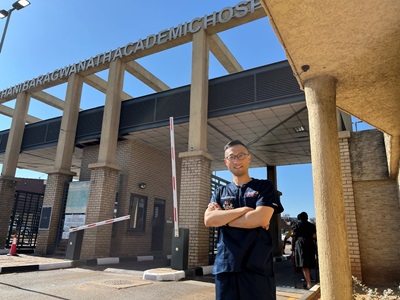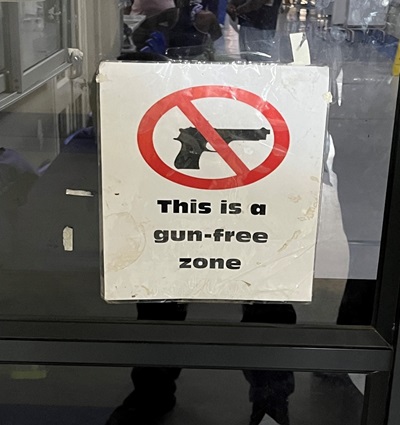2025 | Volume 26 | Issue 3
Author: Associate Professor Victor Kong, MD, PhD, ChM, MSc, DRCPSC, MRCS, FRACS, Trauma surgeon

CHBAH main entrance
The midnight shift
As the clock strikes midnight, I prepare for another on-call shift at the Chris Hani Baragwanath Academic Hospital (CHBAH) in Johannesburg. I have just completed another laparotomy on an unfortunate patient who had been stabbed and knowing more likely there are others on the way.
I hurry back to the resuscitation room to check the status of arrivals, removing my blood-soaked double layered overshoes and waving my hand over the sensor to save a few seconds at the automatic doors. I walk quietly past the sleeping security guard—just 30 metres from the operating theatre. What greets me inside the resuscitation room defies description. Describing it as ‘busy’ does not even come close.

Entrance to the Trauma Unit
Another day (or night) at the office: the resuscitation bay
Inside, the atmosphere is tense—it is noisy, and I can smell the stench of blood, vomit and urine in the heat of the Johannesburg night. This can be overwhelming for those who are not used to such an environment, but for a trauma surgeon, it is just another day (or night) at the office.
The unit is bursting at the seams, and I can hear resonating echoes of the screams of patients who are intoxicated, frightened, and in pain—after having been stabbed, shot, or run over by a car (or a combination of some or all of these). Indeed, the unit resembles a massive urban war zone. As I glance around, I note that all 16 resuscitation bays are full, because I am counting them in my head. The patient in Bay 1 has been stabbed in the neck. In Bay 2 lies a patient with a stab wound to the chest, and in Bay 3 a patient with gunshot wounds to the chest and abdomen. As I count, my thoughts are interrupted by a discussion taking place within earshot between a house officer and a nursing staff about another patient who needs a place in the resuscitation room. As I step backwards to count, I see a medical student taking blood gas for one patient, and a house officer inserting a chest tube into another. A very capable senior surgical registrar is keeping it all under control. In other words, the scene is one of controlled chaos, but everything appears to be working as it should be.
One of the registrars is assessing a young woman who has been stabbed multiple times. She was on her way home after a night out with friends and was robbed by several men soon after she got out of a taxi. What is astonishing is she was left for dead somewhere in Soweto, but managed to shout out to a passerby to call her family, and, eventually, they located her in the middle of the night, put her in a car, and drove her to Bara. She is bleeding from multiple wounds. I can see the pain in her eyes, and the helplessness and shock no one should ever experience. Throughout she is trying to remain composed and stoic as she recounts her story. The registrar interrupts me, informing me that everything is under control, and she is waiting for a CT scan.

Performing a laparotomy for penetrating injuries
The young man in the next bay has been shot multiple times and struck by a car while running away from the perpetrator (or perpetrators). His left leg is deformed, and a registrar is beginning to remove his clothes so he can be assessed fully. The patient says he feels lucky to be alive after his experiences, and I agree with him. As I move from bay to bay, my view is obstructed by several doctors and medical students who are assessing a young man who has been stabbed in the abdomen. This patient tells me he was drinking with a ‘friend’ who accused him of having an affair with his girlfriend, before attacking him. Initially, he did not wish to come to hospital, but eventually realised his injury might be more serious than he had thought—he has evisceration of his small bowel. What is more disturbing is this injury has been inflicted by his ‘friend’.
Violence beyond the walls
At Bara, we see these patients almost every day. But I have never truly understood why some peo-ple inflict such violence on others—or how life can be treated with such disregard. Even after years of working in South Africa, and despite returning many times, the question still haunts me.
Why does this continue? It remains unanswered. As I head back to the operating theatre, passing the now-awake security guard, I wonder—am I missing something? Am I blind to the realities beyond Bara’s walls?